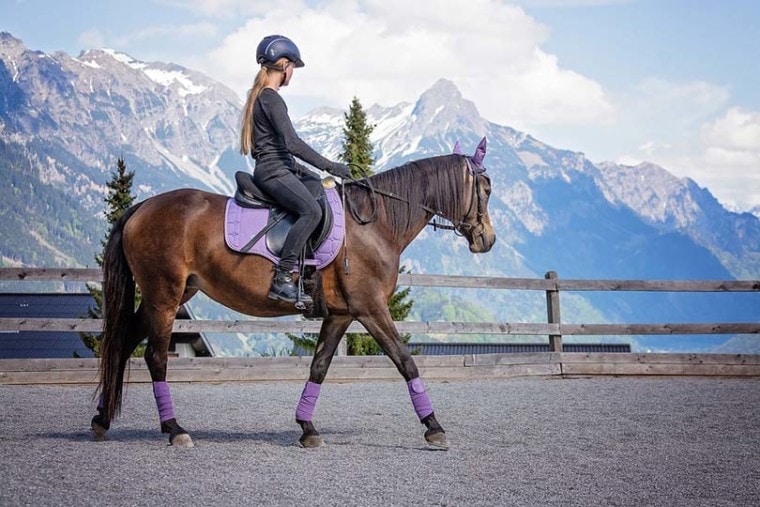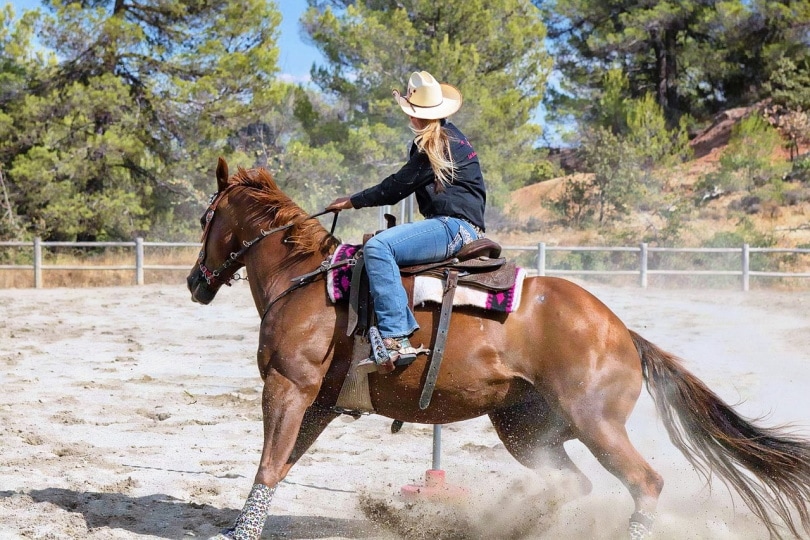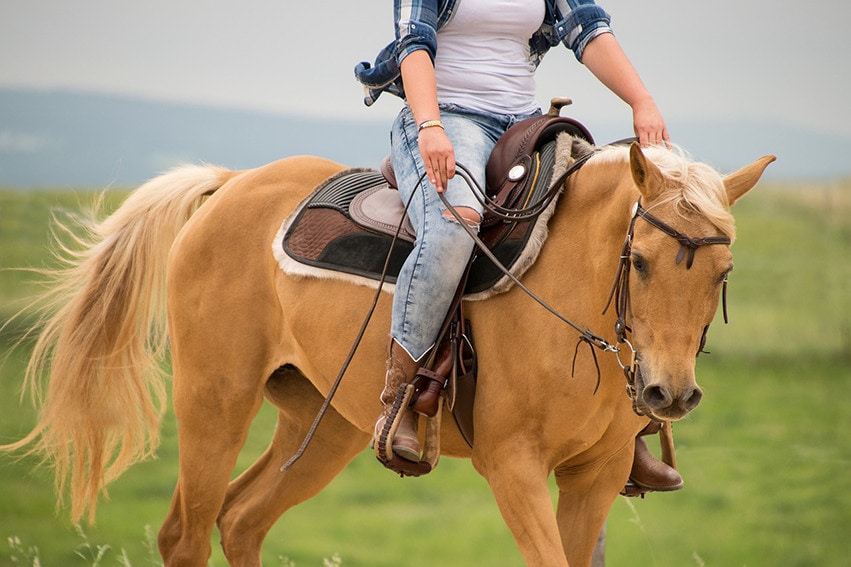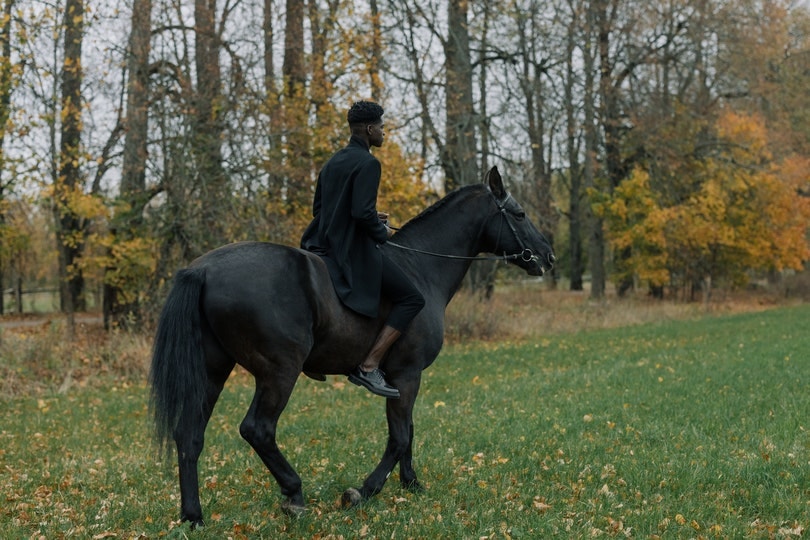
Horses have been ridden for centuries for various reasons but at this point in modern society, people typically choose to ride because they truly enjoy it. Those that have the pleasure of riding horses regularly understand that horses are good for the mind, body, and soul.
If you ride or are interested in riding, you may not be fully aware of all the incredible, scientifically-backed benefits that horseback riding can have on your overall health and well-being. In this article, we’ll take an in-depth look at the significant impact that horseback riding can have on human health.
The 10 Health Benefits of Horseback Riding
1. Improves Mental Health
Spending time with animals is something that many people enjoy, and from hamsters to horses, animals can make heavy impacts on our mental health. Many studies have proven that animals can boost a person’s mood,1 decrease their feelings of loneliness, and make them feel more supported.
There’s nothing quite like being on horseback, though. You can either go on a leisurely ride and take in the sights and sounds of the beautiful outdoors surrounding you or you can pick up the pace and feel like you’re flying as the horse gallops beneath you.
Any seasoned horseback rider knows that you put your trust in your horse and that horse puts its trust in you. You share a bond that is indescribable to those that have never had the pleasure of feeling it.
Horseback riding is a mixture of the health benefits of being in nature and the health benefits of forming a deep connection with a sentient being. Being outdoors alone has been proven to help treat mild to moderate cases of anxiety and depression.

2. Reduces Stress
Any regular rider will tell you that horseback riding is their go-to activity to take a break from the constant stress of everyday life. When you are riding a horse, you need to be in a sense of calm and leave all your worries and anxieties at the door.
Horses have an incredible knack for picking up on your energy, so much so that it can influence theirs as well. Any experienced horseback rider is aware of the way these energies can bounce back and forth, and that’s why it can be very natural to leave those stresses at the barn door and get ready for a nice, relaxing adventure.
When you are on horseback you are out in nature, which alone has been shown to reduce stress levels.
3. Improves Core Strength
Your core is the central part of your body that includes your stomach, hips, lower back, and pelvis. You have probably heard about how important it is to strengthen your core, which is beneficial in many aspects of daily life. Horseback riding isn’t just sitting around and enjoying a ride as it may seem to an outsider.
Horseback riding will help improve and strengthen your core muscles because the act of riding requires you to have balance and stability for a comfortable ride. Keeping yourself balanced in the saddle activates your core and the more you do it, the more core strength you will build.

4. Increases Muscle Tone
Not only is horseback riding great for building core strength, but frequent riding will also help you increase muscle tone throughout the body and will enhance your range of motion.
Those that are just beginning horseback riding or have had a lapse in time since their last ride will undoubtedly feel it the next day, just like you would after hitting the gym after a long period of absence.
Every aspect of horseback riding will engage your muscles, whether you are mounting, keeping pace, changing direction, or maintaining your stability. While walking, trotting, cantering, or galloping, your muscle groups are hard at work.
A recent study completed at South Korea’s Hanseo University’s Research Institute of Sports and Industry Science revealed some incredible information.2 The study included a group of women with no current exercise regime and no prior horseback riding experience.
Over 8 weeks, the women in the horseback riding group gained a considerable amount of muscle tone in thighs, hips, and torsos with some even doubling their muscle tone from the beginning of the study.
5. Enhances Balance and Coordination
To maintain stability while on horseback one must line up their center of gravity with the horse’s center of gravity. This involves a lot more effort than you’d think since the horse’s center of gravity is always oscillating.
Maintaining your balance while you ride will make you more comfortable and secure while also being easier on the horse. To find your balance you must maintain proper posture while in the saddle, align your body and distribute your weight evenly with your feet securely in the stirrups.
It’s easy to tell when you are unbalanced as you ride. This imbalance will actually help you in the long run because it will cause you to find that balance to maintain your comfort as you go. It involves a lot of core strength and muscle use, but once a person is used to riding it becomes second nature.
Your ability to balance while on horseback will translate over into your daily life. Studies have been conducted to back up these claims for horseback riding in normal adults3 and in a therapeutic setting aimed at improving the balance of the elderly and those with disabilities.4

6. Burns Calories
It’s easy to dismiss the exercise you are getting on the back of a horse when the horse is doing all the walking and heavy lifting. While these incredible animals deserve all the credit due for the work they put in, horseback riding is a workout for the rider, too.
Because the rider is putting forth a fair share of energy expenditure, calories are being burned. Engaging your muscles and working to stay in balance is much more of a workout than it may feel. Once you get into the flow of riding, these movements become very natural so it’s easy to forget how much you are actually doing.
Researchers put this to the test at Texas A&M University and concluded that riding a horse for 45 minutes at a walk, trot, and canter can burn up to 200 calories. Those involved with more strenuous riding like cutting and reining were shown to burn nearly 7 calories per minute for the entirety of the riding session.
7. Lower Blood Pressure
One of the many health benefits of regular exercise is lowering blood pressure. Research has shown that regular physical activity can lower high blood pressure by 5 to 8 mm Hg. We’ve already discussed how horseback riding translates into exercise; therefore, it can certainly help in this area as well.
It’s recommended that people aim for at least 30 minutes of moderate physical activity per day to lower their blood pressure and maintain a regular regimen to keep it down. There are plenty of ways to keep physically active but hopping on a horse and going for a ride is a preferred method for horse lovers.
Being around animals has also proven to help lower blood pressure and horseback riding is also great for unwinding and reducing stress, so it’s a win-win.

8. Boosts Cardiovascular Health
Horses aren’t just great for the heart in a metaphorical sense, they can truly be good for your heart health. Horseback riding has proven to be a great aerobic exercise and what’s one thing your doctor will recommend for optimal heart health? You guessed it – aerobic exercise.
Riding can really get your heart pumping. Studies have shown it is associated with heart rates between 136 and 188 beats per minute. To put things into perspective, your average 20-year-old would be considered as performing a moderately intense activity with a heart rate between 128 and 152.
Research has shown that mental health issues and high-stress levels are directly associated with risk factors for heart disease. So, not only is horseback riding an excellent cardio workout, but it also helps in other areas that are good for your heart, like reducing stress and improving your overall mental health.
9. Helps Improve Cognitive Ability
There is a lot of emotion involved between a horse and its rider, which can aid the rider’s emotional awareness and control. You never know what you will encounter while you are riding but you learn to communicate with your horse and work with them to overcome any challenges or obstacles along the way.
Not only do you have to remain sharp in the saddle, but you have to maintain control of the horse and ensure it feels safe under your lead, which also helps with confidence and leadership skills. Horseback riding and participating in riding activities can improve memory, help with concentration, and enhance problem-solving skills.

10. Promotes Relaxation
Considering that we’ve learned that horseback riding is a calorie-burning, muscle-toning exercise that also requires your head to be in the game, how on earth can it promote relaxation? The truth is, while you are engaging your muscles and your heart rate is higher than normal, you are also getting a release of endorphins in the brain, which increases the feeling of well-being.
It’s not just the exercise-induced endorphins that play a role though. Being in the presence of the horse and sharing the bond also promotes a sense of calm. If that isn’t enough, riding pulls you away from the busy, stressful world full of noise and chaos and releases you into nature’s embrace, which is often very peaceful and relaxing on its own.
Ways to Ride Horses If You Don’t Own a Horse
There may be numerous benefits to horseback riding, but not everyone has the luxury of owning their own horse. Not only are they expensive to keep, but most people don’t have the space or ability to keep horses.
If you used to ride but can no longer do so because of life circumstances, or you are interested in horseback riding but have never done so, there are some surefire ways to get you in the saddle so you can enjoy all these wonderful benefits that horses have to offer.
Take Riding Lessons
Don’t think that horseback riding lessons are just for the kiddos; you can learn this skill at any age. Riding lessons aren’t just for beginners, either. Those with prior riding experience understand that you can always learn something new or take some time to freshen up your skills, so regardless of where you stand in knowledge or experience, you can always opt to take lessons at any time in your life.
You can typically choose between individual or group lessons. If you are interested in socializing with fellow horse lovers, it’s a great way to interact with and get to know others with similar interests. You won’t just be limited to riding either, you’ll often get to partake in grooming, care, and quality time with the horses.
Go for a Trail Ride
If you can’t commit to regular riding lessons but just want to get in the saddle and go for a ride, search for nearby stables that offer paid trail rides. You can typically choose between private rides or going along with a larger group.
Most stables offer different levels of trails and lengths of time for these rides. This allows you to choose which setting works best and how long you’d like to be out. This is a great option for those that don’t have access to horses but just want to get out of the house and enjoy being on horseback every once in a while.
Horses that are used for trail rides are very calm and well-trained, so even the most inexperienced riders can enjoy the occasional trail ride.
Lease a Horse
Equestrians and horse lovers may have the option of leasing a horse if they are not in a position where they can commit to owning one. With leasing, you pay a set fee to ride a certain horse that is owned by someone else. It comes with much fewer financial and care responsibilities, but still gives you access to the horse.
Leasing can be related to equestrian sporting events or even casual riding in some cases. There are different levels of the lease such as a partial lease, where you may not be the only person with access to that horse, or a full lease where you would be the only rider.
These lease agreements can vary significantly so it’s best to reach out to the stable that offers these services nearby to learn more about what’s offered in your area.
Board a Horse
If you have the finances to own a horse but just don’t have the property or space to make it happen, you have the option to board a horse that you own on someone else’s property. In this case, you pay either a weekly or monthly fee to the stable owner to keep your horse.
Shelter and pasture access can vary depending on the stable and what they offer, but there are generally two types of boarding offered:
Volunteer at a Horse Rescue
One of the most rewarding ways to get regular access to horses is by volunteering at a horse rescue. These places work tirelessly to save the lives of unwanted and neglected horses that would otherwise be shipped to slaughter.
Rescues must tend to the financial and care needs of these horses, and they can often use all the help that they can get. All different types of horses find their way into these rescues, and you can volunteer to help keep them used to being under saddle, offer training services, or even just help with care and maintenance.
Conclusion
It’s no secret that animals have a way of bringing out the very best in humankind. Science has proven over and over again how beneficial they are for our health both physically and mentally. Being on horseback not only benefits the rider through physical activity but also improves mental health, reduces stress, and much more. Even if you don’t have access to your own horse, there are many options to consider if you want to hop in the saddle and enjoy these incredible benefits.
Featured Image Credit: Pezibear, Pixabay








